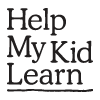What to do with this activity?
Every child is different. Many children struggle with reading, writing and spelling. In some cases this has to do with a specific learning difficulty called dyslexia.
Children with dyslexia can have problems with letters and numbers because of the way their brain sees and understands symbols. Some are only mildly dyslexic, while others are more severely affected. Dyslexia affects approximately one out of every ten people, so it is likely that there are children with dyslexia in every classroom.
If you have any concerns about your own child, talk with their teacher. If dyslexia is diagnosed, there are lots of ways parents can support their child's learning. For instance, have a look at the section "How parents can help" on the Dyslexia Association of Ireland website.
Explore this website (www.helpmykidlearn.ie) for other fun ways of supporting your child's learning.
-
Why am I doing this?
The written word is everywhere and by pointing out words around you everyday, your child will realise the usefulness of reading and how it brings information and knowledge of the wider world into your lives.
Reading together shows your child that you think reading is important. It helps your child to link the words on the page to how they are spoken and to begin to recognise words.
-
How can I do more?
Encourage your child to read by giving them books or information about what they are interested in, for example, if they are interested in cars, give them books about cars – it’s a great motivator. Use comics, magazines and newspapers to provide lots of new words and facts. Your child can use the pictures for information about the words they are reading.
Read longer books to your child. This will help with memory.
You could do ‘paired reading’ – your child chooses a book or comic to read.
- At first, both of you read aloud together. When the child is ready, they carry on reading alone.
- If they don’t know a word, you say it for them and both of you continue to read together until they are ready to read alone again.
- No pressure is made to get them to read by themselves. They only do it when they are ready. This is useful with older children when they find text books difficult.Your child might like to practise their reading skills by reading to younger children.
Discuss with your child’s teacher if they are having difficulty reading.
Rate this activity
![]()
![]()
![]()
![]()
![]()
Based on 1 review
How would you rate it?
1 = Poor, 5 = Great.



